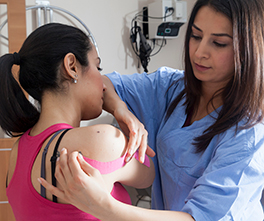As life in the pandemic continues while working from home, many people are experiencing some new aches and pains created by this new way of life.
The clinicians from Hartford HealthCare Rehabilitation Network’s Norwichtown outpatient clinic say that they have seen an uptick in patients coming to them with issues they developed while working remotely.
One patient described intense shoulder pain after building a new deck. Another said that without baseball games, children’s play dates, and other social gatherings, the family finished their dream garden. But now someone’s feeling wrist pain, causing a struggle to perform simple tasks such as opening a jar.
“Both of these patients were diagnosed with a form of repetitive injury,” said Elizabeth Sweetland, an Occupational Therapist at the Norwichtown clinic. “The COVID outbreak might have given us more time for home projects, but too much of good thing is not always good for our bodies.”
Sweetland said repetitive strain or injury is usually defined by gradual buildup of damage to muscles, tendons and nerves from repetitive motions. These types of injuries typically result from long hours of sitting, consistent poor posture, and decreased breaks from work. Most of these injuries are non-surgical and can be managed by adopting better habits, a few of which Sweetland and her team outlined below.
- Maintain correct sitting posture. Have hips and knees at 90 degrees and shoulders back (no slumped posture). This will keep all joints in the neutral position. Even with good posture the body needs to move.
- Take frequent breaks, every 45 minutes or so, and try stretching your body. This will give your body time to send feedback on how the muscles are handling your current activity level.
- Change up your motion throughout projects to not use the same muscle. If doing overhead movements, take a break after and change to lower or waist level activities.
- When lifting objects, look straight ahead, keep back straight, chest out and shoulders back. Lift yourself with your knees while keeping your back straight. This transfers the weight to the leg muscles which are more equipped to handle it.
- Stretch before, during, and after projects or activities. This will keep the muscles flexible and ready to handle all awkward movements thrown its way.
- When restarting a new workout program or increasing the program, always start slow and work your way up to more advanced levels as you gain strength.


